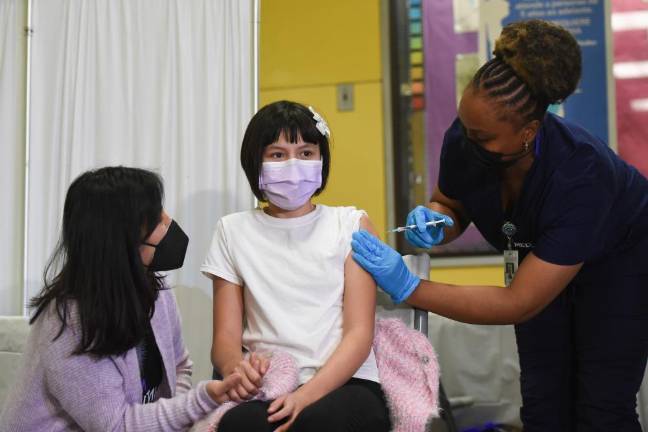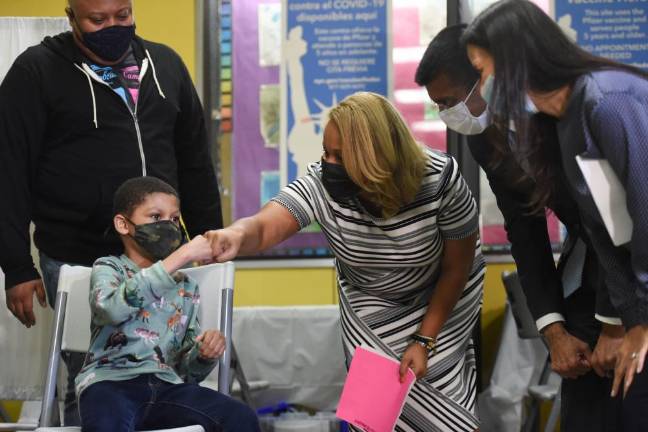A New COVID Surge
City officials are preparing for “a winter wave” and expand booster shots for all New Yorkers 18 and over


COVID rates are climbing again in New York City.
This news may not yet be cause for alarm, but it is certainly reason for attention and caution, experts say.
“We need to manage this pandemic to where it is no longer a crisis,” said the Manhattan Borough President-elect, Mark Levine, chair of the City Council health committee. “But it appears we are heading into a winter wave. Cases are rising, but we have the tools to stop that.”
New York City is neither alone nor the most severe, yet, in experiencing new spikes in Sars-CoV-2 infections. From Germany to Minnesota the virus is finding the unvaccinated and those who are vaccinated but remain vulnerable because of age or health.
Austria on Monday announced that the unvaccinated (and those who can’t show immunity through prior infection), will be largely confined to their homes for ten days to curb a COVID-19 surge higher than anything the country has previously experienced.
While New York City and other communities have barred the unvaccinated from activities like indoor dining and movie-going, this was thought to be one of the first efforts to lock down the unvaccinated.
“We are watching the situation in Europe very carefully,” Mayor Bill de Blasio said Monday. “We are concerned.”
Full Vaccination
The mayor said New York City was in better shape because of higher vaccination rates, although the difference is not that large. Just under 65 percent of Austria’s 8.9 million population are fully vaccinated, only slightly behind the 68 percent of New York City’s 8.3 million who are fully vaccinated.
The city’s health commissioner, Dr. Dave Chokshi, said full vaccination remained key to preventing a winter surge. He announced that any New Yorker 18 or over was now eligible for a booster, a step the federal government has not yet taken. “We don’t want anyone turned away from a booster dose,” Chokshi said.
Since hitting its most recent peak at a daily average of 159 new cases per 100,000 New Yorkers on September 15, COVID-19 infections had declined steadily to a daily average of 68 cases on November 1, still substantial under federal definitions but improving. But since then, the daily average of new cases has begun climbing again, hitting 82 per hundred thousand on November 9.
While it is not quite right to say this is a pandemic of the unvaccinated, infection rates are far higher among unvaccinated New Yorkers – thirty two cases per 100,000 among the vaccinated, for example, versus 222 cases per hundred thousand among the unvaccinated as of October 30, the most recent date made available by the New York Health Department.
Since the weather so far has been mostly mild, the upsurge is more likely a result of increasing activity in general this fall rather than the specific problem of cold weather driving more of that activity indoors, a clear challenge ahead for the holidays.
Outdoor Dining
Take, for example, the scene at the Elgin Restaurant on West 48th street on a pleasant evening last week. Two couples in their 60s and 70s stopped at the Elgin’s outdoor dining structure for a quick pre-theater dinner. A law professor, a recruiter, a college administrator and a writer. All fully vaccinated, but nevertheless wary of COVID-19.
As they enjoyed dinner, the structure, which is closed on three sides, filled with other guests, mostly standing and drinking, unmasked. The restaurant is not required to check for vaccination outdoors.
The structure did not meet the city’s requirement that outdoor dining be open on three sides. It was also noisy both from music and the crowd and there was no social distancing. Drinking in loud settings is often cited as a risk factor for spread of the virus, as voices are raised with the expelling of breath.
“It felt like I was in a space that was closing in as the cocktail hour, pre-theater drinks crowd grew,” said the college administrator. “I felt like it was in an open space that was closing in on me. It was packed with unmasked people ... they were practically on top of us while we were eating.”
The professor grew increasingly uncomfortable as the crowding intensified, visibly flinching as one of the drinkers towered over him.
“In a city where we are still on guard, to be surrounded by a large group of loud, unmasked drinkers in what was an only partially opened outdoor pavilion was creepy,” the professor later said. “Surrounded by COVID aerosol bombs.”
The Elgin did not respond immediately to a request for comment.
Density as a Risk Factor
One encouraging piece of data, is that while infections are on the rise again in New York, hospitalizations and deaths are not, suggesting that vaccinations and improved treatments are making a difference.
In authorizing booster shots for all adult New Yorkers even before the federal government has done so, Chokshi cited the density of New York as a risk factor that justified the move.
He said three steps were crucial to keeping the uptick in cases from becoming a winter wave. The first is vaccinating the unvaccinated, including the push to vaccinate 5- to 18-year-olds.
Second was the expansion of booster shots for anyone over 18.
And the third is, “For all of us, regardless of our vaccination status, to take the common sense public health precautions that have worked throughout the pandemic. Wearing a mask, particularly indoors. Using testing. Staying home when you’re sick. Ventilation. Hand hygiene. All of this is simple but remains very important ahead of the cooler months.”
Despite his concerns about a winter surge, de Blasio pressed forward with a highly symbolic piece of New York’s reopening, the return of New Year’s Eve in Times Square. “We expect a large, wonderful celebration,” the Mayor announced. “We’re going to have some clear smart rules to keep everyone safe.”
The city’s health commissioner, Dr. Dave Chokshi, said full vaccination remained key to preventing a winter surge ...“We don’t want anyone turned away from a booster dose,” Chokshi said.